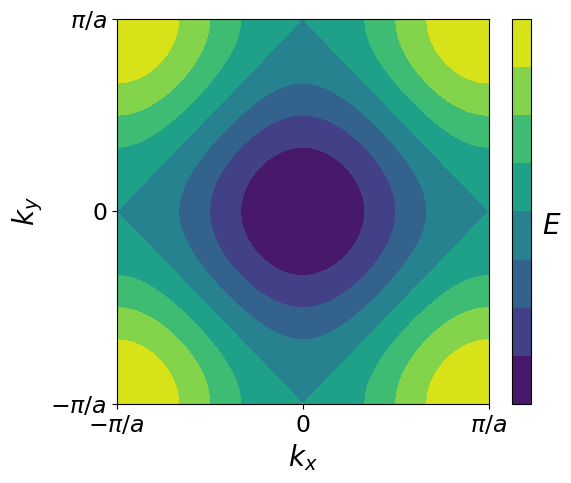Solutions for lecture 12 exercises¶
from matplotlib import pyplot as plt
import numpy as np
from math import pi
Exercise 1: 3D Fermi surfaces¶
Question 1.¶
Well described: (close to) spherical.
Question 2.¶
K is more spherical, hence 'more' free electron model. Li is less spherical, hence 'more' nearly free electron model. Take a look at Au, and see whether you can link this to what you learned in lecture 11.
Question 3.¶
Yes. Cubic -> unit cell contains one atom -> monovalent -> half filled band -> metal.
Question 4.¶
With Solid State knowledge: Na has 1 valence electron, Cl has 7. Therefore, a unit cell has an even number of electrons -> insulating.
Empirical: Salt is transparent, Fermi level must be inside a large bandgap -> insulating.
Exercise 2: Tight binding in 2D¶
Question 1.¶
Question 2.¶
Question 3.¶
Question 4 and 5.¶
Monovalent -> half filled bands -> rectangle rotated 45 degrees.
Much less than 1 electron per unit cell -> almost empty bands -> elliptical.
def dispersion2D(N=100, kmax=pi, e0=2):
# Define matrices with wavevector values
kx = np.tile(np.linspace(-kmax, kmax, N),(N,1))
ky = np.transpose(kx)
# Plot dispersion
plt.figure(figsize=(6,5))
plt.contourf(kx, ky, e0-np.cos(kx)-np.cos(ky))
# Making things look ok
cbar = plt.colorbar(ticks=[])
cbar.set_label('$E$', fontsize=20, rotation=0, labelpad=15)
plt.xlabel('$k_x$', fontsize=20)
plt.ylabel('$k_y$', fontsize=20)
plt.xticks((-pi, 0 , pi),('$-\pi/a$','$0$','$\pi/a$'), fontsize=17)
plt.yticks((-pi, 0 , pi),('$-\pi/a$','$0$','$\pi/a$'), fontsize=17)
dispersion2D()

Exercise 3: Nearly-free electron model in 2D¶
Question 1.¶
Construct the Hamiltonian with basis vectors \((\pi/a,0)\) and \((-\pi/a,0)\), eigenvalues are
Question 2.¶
Four in total: \((\pm\pi/a,\pm\pi/a)\).
Question 3.¶
Define a basis, e.g.
The Hamiltonian becomes
Question 4.¶
Using the symmetry of the matrix, we try a few eigenvectors: $$ \mathbf{v_\pm}= \begin{pmatrix} 1 \ \pm 1 \ 1 \ \pm 1 \ \end{pmatrix} $$ $$ \mathbf{v_\alpha}= \begin{pmatrix} \alpha \ 1 \ -\alpha \ -1 \ \end{pmatrix} $$